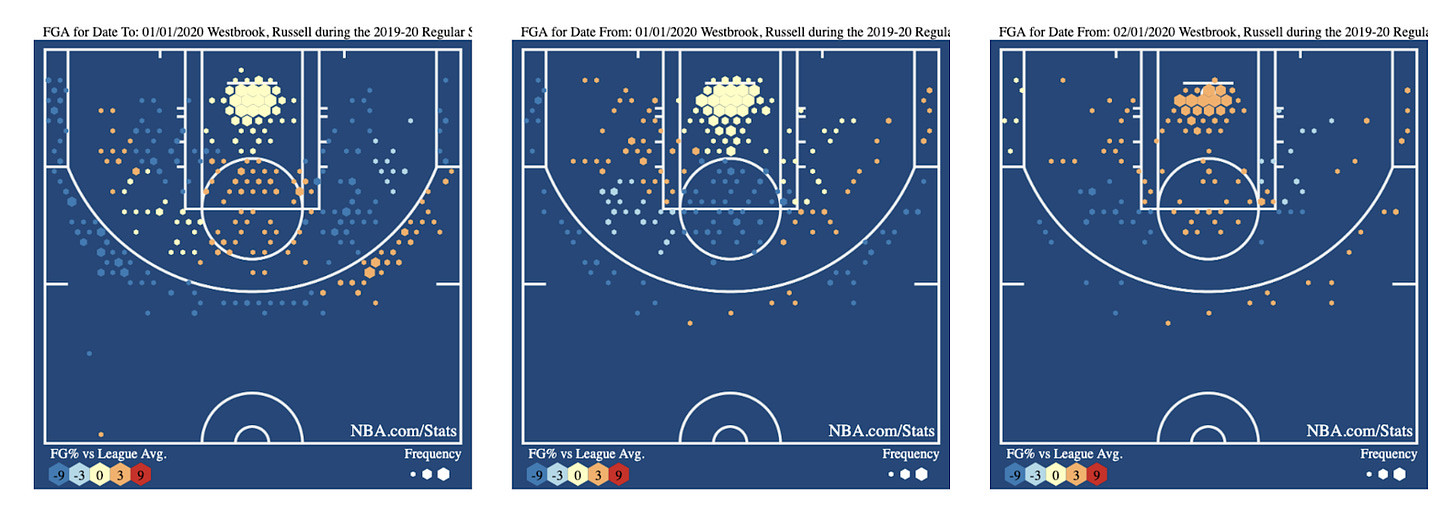Why is this interesting? - The Modern NBA Edition
On basketball, strategy, and the questioning of conventional wisdom
This may look like a basketball WITI when you skim the headline. But it is fundamentally a strategy post, showing the calculus of the game, who is drafted and put in what position, and how the game evolves in time. Laypeople and non-basketball fans can take something away, not just those obsessed with hoops. - Colin (CJN)
Noah here. The NBA is planning on resuming its season at the end of July. The league is reportedly spending $150 million to house 22 teams at Disneyworld in Orlando, where there will be a short conclusion to the regular season followed by a full 16-team playoff. Those who decide to go will be cut off from their families and communities until they’re eliminated from contention or families are allowed to join at the end of August (whichever comes first). Not surprisingly, several players have opted out of the “Bubble” for a host of reasons.
Obviously, restarting professional sports after months off is going to be an odd experience, not the least of which is it’s hard to think back to where we left off. The NBA’s trade deadline—the last big chance to remake a team for a playoff run—was at the beginning of February. The league suspended play a few weeks later on March 11th, meaning those teams that made the most drastic changes at the deadline had only about one month to find a new groove before the four-month hiatus.
No team’s identity changed more at the beginning of February than the Houston Rockets. The team is probably best known for getting the Michael Lewis treatment as a leader in bringing “Moneyball” (data over emotions) to the NBA. They’re led by James Harden, who has become a poster child for the data-first approach to the sport, focusing on nothing but three-pointers, layups, and free throws— the three highest value shots in the game. Before the season the team also acquired Harden’s former teammate Russell Westbrook, a player best-known for thundering dunks (despite being only 6’3”) and averaging a triple-double (10+ points, assists, and rebounds in a game) for an entire season, a feat only achieved once before in NBA history. The move left some confused, as the Rocket’s favorite shot is the three-pointer, which they take more than any other team in the league. Notably, it also happens to be Russell Westbrook’s worst shot.
So how did the Rockets make it work? They traded their center at the deadline in early February, paving the way for a different kind of basketball experiment.
Why is this interesting?
When we think of basketball, we think of giants. Outside of a few famous players like Michael Jordan, Larry Bird, and Magic Johnson, the best-known athletes in the sport’s history were centers—the largest person on the floor who plays almost exclusively near the basket. Players like Shaquille O’Neal (7’1”) and Kareem Abdul-Jabaar (7’2”) made amazing careers patrolling the paint, bullying and skyhooking their way to the Hall of Fame. For the vast majority of NBA history, conventional wisdom said having one of these hulks was the key to success.
But basketball has been undergoing a modernization over the last fifteen years as teams fully realized the value of the three-point shot despite being part of the game for over 30 years. The simplest explanation is that someone finally looked at the math and realized that taking a three-pointer with a 33% likelihood of going in had a higher expected value than a two-point shot with a 49% chance of going in. With that, teams started to focus their schemes on taking shots from behind the three-point line or close to the basket, abandoning the “midrange” between those two areas, where shots tend to go in less than 50% of the time. Thus the “pace-and-space” era was born as teams tried to open up the floor as much as possible (space) and move the ball more quickly (pace) to increase the shots they took in a game. As teams spread out on the floor more and more, your big man who can only shoot near the basket started to flip from an asset to a liability, as teams could play off non-shooters and mess up the spacing these new-style teams worked so hard to create.
To fix that, many teams started to experiment with playing smaller lineups. When Lebron James was in Miami, a big part of their championship run was realizing they could play Chris Bosh, the team’s forward, at center. Because he was a much better shooter than the actual center, the team became significantly harder to defend. The Golden State Warriors took this to another level, becoming the most successful team in the pace-and-space era and amongst the all-time greats. They won their championships with their most important center minutes going to the 6’6” Draymond Green. It worked because Green is a fantastic defender, and every other player on the floor was a threat to score.
While the Rockets have been fully bought into pace-and-space for some time, they were still playing with a more traditional big man in 6’10” Swiss center Clint Capela. When Russell Westbrook came along, that meant there was someone else occupying the real estate in which he does his best work. And so, as often happens in the NBA, the superstar got his way, and the team traded away his only competition for space in the paint. The team moved to starting 6’5” PJ Tucker at Center, meaning their entire starting lineup was under 6’6” tall. Tucker would defend the opposing team’s big man on defense and on offense would hang out by the three-point line, leaving the part of the court that is typically reserved for seven-footers to the 6’3” Westbrook (who, it should be noted, is one of the fastest and most athletically gifted players in the NBA). Before January 1st Westbrook was taking around 45% of his shots within ten feet while in the games after that number jumped to 63%.
To see just how drastic the shift was, check out the image below. The first shot chart shows Westbrook’s shooting prior to 1/1. You’ll notice far more shots outside the arc and just within (the midrange). When you look at the middle chart, however, you can start to see things get much more sparse as he moves away from the basket. Finally, isolating just shots after February 1st, you can see that almost all other shots are gone, and the darker color at the basket indicates that Westbrook was actually also shooting better from that area, likely a result of having fewer defenders to deal with when he drives to the rim.

In the end, it’s unlikely any of this will mean the Rockets win the title this year in Orlando. Basketball is a “strong link” sport—meaning that the most significant determinant of success is your best player—and as good as James Harden and Russell Westbrook might be they’re not Lebron James, Kawhi Leonard, or Giannis Antetokounmpo. But it’s fascinating to see a team continue to push the boundaries of what it means to play basketball. Before the last ten years or so, positions in the sport came along with size expectations. Point guards were small guys who could dribble, pass, and shoot, and Centers were the biggest guys on the floor, blocking shots and shooting hooks. Now you have guys like Lebron James (6’9”), Ben Simmons (6’10”), and even Giannis Antetokounmpo (6’11”) effectively playing the point guard role and on the other side Draymond Green and PJ Tucker/Russell Westbrook questioning the logic that the center position must be occupied by a big man. As teams have gotten smarter about what actually wins games, they’ve evolved their understanding of the players and skills you need to win. It’s fun to watch. (NRB)
App of the Day: The New Stand
A WITI programming note: We like the mission of retail company The New Stand: “a day improvement company.” So it is fun to announce that we are now featured in their app, as part of their content mix. When commuting returns to being a thing, lots of NYC ferry riders will likely see us as they get their morning coffees. They also just opened an outpost in Tokyo. Download the app (Apple) or (Android) when you get the chance. (CJN)

Quick Links:
A Boeing 777 made from manilla folders (CJN)
LRB on Concorde (CJN)
On running and heart rate (CJN)
Thanks for reading,
Noah (NRB) & Colin (CJN)
—
Why is this interesting? is a daily email from Noah Brier & Colin Nagy (and friends!) about interesting things. If you’ve enjoyed this edition, please consider forwarding it to a friend. If you’re reading it for the first time, consider subscribing (it’s free!).


